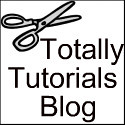With the Bean's debut just around the corner I'm not up to major projects at the moment so I may get a few tutorials done before she comes along and I may just get this one done and follow up once we're all sorted as a family of four instead of a family of three. We'll see how things go and I'll just ask for your patience now and get it out of the way.
The first step in making a hand bound book (outside of getting text together and breaking it up into page sized bits) is getting your signatures (or in my case; a signature) ready. A signature is a group of folded pages that make up a booklet which is then sewn together and attached to the hard cover of your book.
Today I'll show you how to find the grain in your sheet of paper so that you can cut your paper to make a signature for a hand bound book.
What you will need:
Paper
Ruler
Pencil
X-acto Knife
Soft Bristle Brush
Water
 Paper Grain
Paper GrainWhen working with artist grade paper especially when you are going to be using artist grade paper for book making you should be aware of which way the paper grain is before you measure and cut your paper for signatures and for accordion folds. Paper grain refers to the direction that most of the fibers that make up the paper lie. During paper making the fibers that make up the paper tend to align themselves in one direction. Most artist grade papers are made using cotton fibers.
The best way to figure out which way the papers grain runs is to bend your sheet of paper. One side will roll easier than the other; the smaller the sheet of paper you are working with the more dramatic the difference will be. The side that bends the easiest is where the grain runs. You will be folding your signature parallel to the grain.
 Measuring and Cutting
Measuring and CuttingNow that you know which edge is parallel to your paper grain measure your paper for cutting. For my book I am making a 5.5"x7" book. I will be cutting sheets for my signature that are 11" x 7" with a fold made 5.5" in on the 11" length that runs running parallel to the grain of my paper.
I will be using two methods of cutting my paper for this book. the tops and bottoms of my pages will be cut using a blade for a straight edge and for the outside edges of my signatures I'll be making a deckle edge using water and a brush.
Straight Cut:
 Using your ruler and a sharp pencil measure out where your cuts are going to be made. I measured down the length of my paper in 7" increments in three separate places along the page. This way I can line up my ruler along each mark and double check that my measurements are exact before I cut.
Using your ruler and a sharp pencil measure out where your cuts are going to be made. I measured down the length of my paper in 7" increments in three separate places along the page. This way I can line up my ruler along each mark and double check that my measurements are exact before I cut.Laying your straight edged ruler along your measure line you can then take your x-acto blade and run it along the straight edge. It is best to use light even cuts and go over the cut more than once than to put a lot of pressure on a single cut. Keep your hand on the ruler to hold it down along where you are making your cut. This means that you will be moving your ruler hand along with your cutting hand as you make your cut. This gives your ruler edge support during the cut and also ensures that you are paying attention to what your blade is doing.


Deckle Edge:
 Now that I've cut the straight edges on my sheets I have a tidy stack of four 7" x 22.5" sheets.
Now that I've cut the straight edges on my sheets I have a tidy stack of four 7" x 22.5" sheets.I want to make these into smaller 7" x 11" sheets with a deckle edge along the 7" edge of the sheet. I'm using Opus European Watercolour paper which has deckle edges already so I will be creating a deckle edge to match when I make the sheet smaller.

 To illustrate paper grain a little more I've included two more images with these smaller sized sheets, you'll notice that the paper bends much more easily along the longer edge of the sheet. The paper grain then runs parallel to the 7" length of my sheet. This is the length that I will eventually score along for folding
To illustrate paper grain a little more I've included two more images with these smaller sized sheets, you'll notice that the paper bends much more easily along the longer edge of the sheet. The paper grain then runs parallel to the 7" length of my sheet. This is the length that I will eventually score along for folding To do this you need to measure where your tear is going to be made just as if you were going to cut the edge as before. Lay your ruler along the marks for your edge and run a wet paintbrush along the edge. I use a soft bristle brush so that I don't scuff my paper surface. Let the water soak into the paper. The paper I am using is 200lb paper which means that it is quite a heavy paper and needs a few moments for the water to soak in before I can start to tear. As with cutting with a blade keep your hand on the ruler along where you are tearing. Lift
To do this you need to measure where your tear is going to be made just as if you were going to cut the edge as before. Lay your ruler along the marks for your edge and run a wet paintbrush along the edge. I use a soft bristle brush so that I don't scuff my paper surface. Let the water soak into the paper. The paper I am using is 200lb paper which means that it is quite a heavy paper and needs a few moments for the water to soak in before I can start to tear. As with cutting with a blade keep your hand on the ruler along where you are tearing. Lift  the edge of the paper where you want your tear to start and pull. Move your hand farther down the straight edge and tear further along your edge until you have reached the edge of your sheet.
the edge of the paper where you want your tear to start and pull. Move your hand farther down the straight edge and tear further along your edge until you have reached the edge of your sheet.Next time: scoring and folding to make your signature



















No comments:
Post a Comment